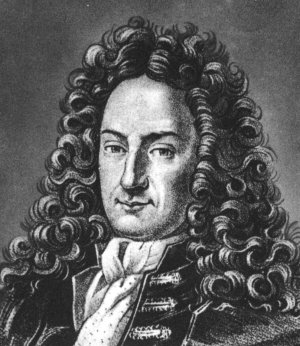The product rule is a formal rule to find the derivatives of products of two or more functions.
In Leibniz’s notation we can express it as
\(\frac{d}{dx}(u . v) = \frac{du}{dx} . v + u . \frac{dv}{dx}\)OR
In Lagrange’s notation as,
\((u . v)’ = u’ v + u v’\)
This rule can be extended to a derivative of three or more functions.
Index
History
Gottfried Leibniz is credited with the discovery of this rule, he demonstrated it using differentials.

Derivation
Leibniz’s Argument:
Let \(u(x)\) and \(v(x)\) be two differentiable functions of x.
Then the differential of \(u.v\) is given by
\(d(u . v) = (u + du) . (v + dv) – u.v\)
\( = udv + vdu + du.dv\)
Since the term \(du.dv\) is negligible compared to \(udv + vdu\), as it becomes very small. So we neglect the term
Hence, Leibniz concluded that
\(d(u . v) = v . du + u . dv\)
dividing bot sides we come to
\(\frac{d}{dx}(u . v) = \frac{du}{dx} . v + u . \frac{dv}{dx}\)
Proof
Let us consider two differentiable functions \(f(x)\) & \(g(x)\), & \(h(x) = f(x)g(x)\).
Here, we will be proving that \(h\) is differential with \(x\) & \(h’(x)\) will be \(f’(x)g(x) + f(x)g’(x)\).
Factorising from first principle,
\(h(x) = f(x)g(x)\)
\(h’(x) = lim_{x \to 0} \frac{h(x + \Delta x) – h(x)}{\Delta x}\)
\(= lim_{x \to 0} \frac{f(x + \Delta x)g(x + \Delta x) – f(x)g(x)}{ \Delta x}\)
Adding and subtracting \(f(x)g(x + \Delta x)\) in numerator,
\(= lim_{x \to 0} \frac{ f(x + \Delta x)g(x + \Delta x) –f(x)g(x + \Delta x) + f(x)g(x + \Delta x) – f(x)g(x)}{ \Delta x}\)
\(= lim_{x \to 0} \frac{[ f(x + \Delta x) + f(x)] . g(x + \Delta x) + f(x) . [g(x + \Delta x) + g(x)]}{\Delta x}\)
\(= lim_{x \to 0} \frac{f(x + \Delta x) + f(x)}{\Delta x} . lim_{x \to 0} g(x + \Delta x) + lim_{x \to 0} f(x). lim_{x \to 0} \frac{g(x + \Delta x) + g(x)}{\Delta x}\)
Since, \(lim_{x \to 0} g(x + \Delta x) = g(x)\)
\(h’(x) = f’(x)g(x) + f(x)g’(x)\)
Hence proved.
Application of Product Rule
This rule is used mainly in calculus and is important when one has to differentiate product of two or more functions. It makes calculation clean and easier to solve.
Examples
Question 1. Differentiate the function: \((x^3 + 5)(x^2 + 1)\)
Solution. Here, \(f(x) = (x^3 + 5)\) & \(g(x) = (x^2 + 1)\)
Using this rule we get,
\(\frac{d (x^3 + 5) (x^2 + 1)}{dx} = \frac{d (x^3 + 5)}{dx}.(x^2 + 1) + (x^3 + 5). \frac{ d (x^2 + 1)}{dx}\)
= \((3x^2)(x^2 +1) + (x^3 + 5)(2x)\) = \(3x^4 + 3x^2 + 2x^4 + 10x\)
=> \(5x^4 + 3x^2 + 10x\).
Question 2. Find the derivative of \(h(x)\), if \(h(x) = f(x)g(x)\) & \(f(x) = sin(x)\) & \(g(x) = cos(x)\).
Solution. Given, \(h(x) = sin(x) . cos(x)\)
Therefore, \(h’(x) = cos(x)cos(x) + sin(x)(- sin(x))\)
\(\Rightarrow cos^2(x) – sin^2(x)\)
\(\Rightarrow cos(2x)\).
FAQs
It is a rule followed to differentiate the product of two functions,
\((xy)’ = x’y + xy’\)
When there are three terms and this rule is to be applied, we group two functions and treat them as a single unit.
And hence apply the rule to left over two.
Ex. \((fgh)’ = (fg)’h + (fg)h’\)
\(= (f’g + fg’)h + fgh’\)
\(= f’gh + fg’h + fgh’\)
Product rule is used to find the derivative of a product of function, while the quotient rule is used for finding derivative of function’s quotient.
Leibniz Rule is case of product rule in which we differentiate the product ‘n’ times.
